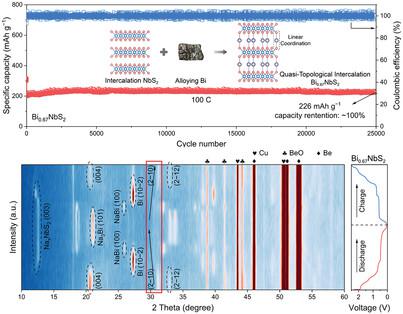当前位置:
X-MOL 学术
›
Adv. Energy Mater.
›
论文详情
Our official English website, www.x-mol.net, welcomes your feedback! (Note: you will need to create a separate account there.)
Quasi-Topological Intercalation Mechanism of Bi0.67NbS2 Enabling 100 C Fast-Charging for Sodium-Ion Batteries
Advanced Energy Materials ( IF 27.8 ) Pub Date : 2023-05-17 , DOI: 10.1002/aenm.202300790 Zhuoran Lv 1, 2 , Hengyue Xu 3 , Wenjing Xu 1, 2 , Baixin Peng 1, 2 , Chendong Zhao 1, 2 , Miao Xie 1, 2 , Ximeng Lv 4 , Yusha Gao 1, 2 , Keyan Hu 1 , Yuqiang Fang 1 , Wujie Dong 1 , Fuqiang Huang 1, 2, 5
Advanced Energy Materials ( IF 27.8 ) Pub Date : 2023-05-17 , DOI: 10.1002/aenm.202300790 Zhuoran Lv 1, 2 , Hengyue Xu 3 , Wenjing Xu 1, 2 , Baixin Peng 1, 2 , Chendong Zhao 1, 2 , Miao Xie 1, 2 , Ximeng Lv 4 , Yusha Gao 1, 2 , Keyan Hu 1 , Yuqiang Fang 1 , Wujie Dong 1 , Fuqiang Huang 1, 2, 5
Affiliation

|
Alloying-type bismuth with high volumetric capacity has emerged as a promising anode for sodium-ion batteries but suffers from large volume expansion and continuous pulverization. Herein, a coordination constraint strategy is proposed, that is, chemically confining atomic Bi in an intercalation host framework via reconstruction-favorable linear coordination bonds, enabling a novel quasi-topological intercalation mechanism. Specifically, micron-sized Bi0.67NbS2 is synthesized, in which the Bi atom is linearly coordinated with two S atoms in the interlayer of NbS2. The robust Nb−S host framework provides fast ion/electron diffusion channels and buffers the volume expansion of Na+ insertion, endowing Bi0.67NbS2 with a lower energy barrier (0.141 vs. 0.504 eV of Bi). In situ and ex situ characterizations reveal that Bi atom alloys with Na+ via a solid-solution process and is constrained by the reconstructed Bi−S bonds after dealloying, realizing complete recovery of crystalline Bi0.67NbS2 phase to avoid the migration and aggregation of atomic Bi. Accordingly, the Bi0.67NbS2 anode delivers a reversible capacity of 325 mAh g−1 at 1 C and an extraordinary ultrahigh-rate stability of 226 mAh g−1 at 100 C over 25 000 cycles. The proposed quasi-topological intercalation mechanism induced by coordinated mode modulation is expected to be be conducive to the practical electrode design for fast-charging batteries.
中文翻译:

Bi0.67NbS2的准拓扑插层机制实现钠离子电池100℃快充
具有高体积容量的合金型铋已成为一种有前途的钠离子电池负极,但其体积膨胀大且持续粉化。在此,提出了一种配位约束策略,即通过重构有利的线性配位键将原子 Bi 化学限制在插层主体框架中,从而实现一种新型的准拓扑插层机制。具体地,合成微米级的Bi 0.67 NbS 2 ,其中Bi原子与NbS 2层间的两个S原子线性配位。强大的 Nb−S 主体框架提供快速离子/电子扩散通道并缓冲 Na +插入的体积膨胀,赋予 Bi 0.67 NbS2具有较低的能垒(Bi 为0.141与0.504 eV)。原位和异位表征表明,Bi原子通过固溶过程与Na +形成合金,并受到脱合金后重建的Bi−S键的约束,实现了结晶Bi 0.67 NbS 2相的完全恢复,避免了Bi 0.67 NbS 2 相的迁移和聚集。原子Bi。因此,Bi 0.67 NbS 2负极在1 C下具有325 mAh g -1的可逆容量和226 mAh g -1的非凡超高倍率稳定性。在 100 C 下循环超过 25 000 次。所提出的由协调模式调制引起的准拓扑嵌入机制有望有助于快速充电电池的实际电极设计。
更新日期:2023-05-17
中文翻译:

Bi0.67NbS2的准拓扑插层机制实现钠离子电池100℃快充
具有高体积容量的合金型铋已成为一种有前途的钠离子电池负极,但其体积膨胀大且持续粉化。在此,提出了一种配位约束策略,即通过重构有利的线性配位键将原子 Bi 化学限制在插层主体框架中,从而实现一种新型的准拓扑插层机制。具体地,合成微米级的Bi 0.67 NbS 2 ,其中Bi原子与NbS 2层间的两个S原子线性配位。强大的 Nb−S 主体框架提供快速离子/电子扩散通道并缓冲 Na +插入的体积膨胀,赋予 Bi 0.67 NbS2具有较低的能垒(Bi 为0.141与0.504 eV)。原位和异位表征表明,Bi原子通过固溶过程与Na +形成合金,并受到脱合金后重建的Bi−S键的约束,实现了结晶Bi 0.67 NbS 2相的完全恢复,避免了Bi 0.67 NbS 2 相的迁移和聚集。原子Bi。因此,Bi 0.67 NbS 2负极在1 C下具有325 mAh g -1的可逆容量和226 mAh g -1的非凡超高倍率稳定性。在 100 C 下循环超过 25 000 次。所提出的由协调模式调制引起的准拓扑嵌入机制有望有助于快速充电电池的实际电极设计。



























 京公网安备 11010802027423号
京公网安备 11010802027423号